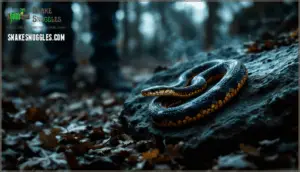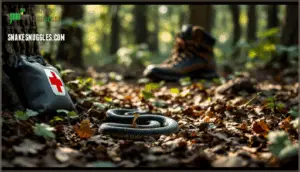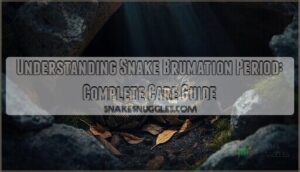This site is supported by our readers. We may earn a commission, at no cost to you, if you purchase through links.
 A copperhead’s bite sends roughly 3,000 Americans to the hospital each year, yet between 1989 and 2018, only five people died from these encounters. That’s a fatality rate of 0.01%—you’re statistically more likely to be struck by lightning.
A copperhead’s bite sends roughly 3,000 Americans to the hospital each year, yet between 1989 and 2018, only five people died from these encounters. That’s a fatality rate of 0.01%—you’re statistically more likely to be struck by lightning.
The gap between fear and reality comes down to venom chemistry: copperheads inject hemotoxic venom that attacks blood cells and tissue, but they usually deliver just 26 mg per bite, far below the 100 mg threshold considered lethal.
Most victims experience painful swelling and tissue damage that heals within weeks, not life-threatening symptoms. Understanding what actually happens when a copperhead bites—and why deaths are so uncommon—can replace panic with practical knowledge about when you truly need to worry.
Table Of Contents
- Key Takeaways
- Can a Copperhead Snake Bite Be Fatal?
- Understanding Copperhead Snake Bites
- Copperhead Snake Safety Tips
- Can You Survive a Copperhead Snake Bite Without Treatment?
- How Dangerous Are Copperhead Snakes to Humans?
- The Threat of Copperhead Snakes to Dogs
- Frequently Asked Questions (FAQs)
- How far away should you stay from a copperhead snake?
- What are the long-term effects of a copperhead snake bite?
- Are there any differences between male and female copperhead snakes?
- Are copperhead snakes more active during the day or night?
- How long can a copperhead snake live in captivity?
- What time of year are copperhead bites most common?
- How do you identify a copperhead snake accurately?
- Are baby copperheads more dangerous than adults?
- What should you do immediately after a bite?
- Do copperheads attack humans or just defend themselves?
- Conclusion
Key Takeaways
- Copperhead bites are rarely fatal, with only five deaths recorded between 1989 and 2018 (a 0.01% fatality rate), despite roughly 3,000 Americans being bitten annually.
- The venom is hemotoxic and relatively weak compared to other pit vipers, with copperheads typically injecting just 26 mg per bite—well below the 100 mg threshold considered lethal to humans.
- Most bites cause localized pain, swelling, and tissue damage that heals within weeks, and antivenom treatment can cut recovery time nearly in half when administered promptly.
- Dogs face higher risk than humans due to their smaller body size and curious behavior, with most bites occurring on the face or front legs and requiring immediate veterinary care to prevent serious complications.
Can a Copperhead Snake Bite Be Fatal?
The short answer is reassuring: deaths from copperhead bites are extremely rare. However, understanding the actual risk requires looking at both the statistics and the science behind their venom.
Let’s break down what makes copperheads dangerous—and why fatal outcomes almost never happen.
Copperhead Snake Fatalities
Here’s something that might surprise you: copperhead bite fatalities are extraordinarily rare. Between 1989 and 2018, only five deaths were attributed to copperhead attacks in the United States—that’s roughly one death every four years. With approximately 2,920 people bitten annually, the case-fatality rate sits at about 0.01%. Understanding venomous snake actions is vital for preventing bites.
Snake bite fatalities from copperheads represent just one in 20 snakebite deaths nationwide, despite copperheads causing more bites than any other venomous snake in North America. The copperhead venom composition is far less potent than other pit vipers, and copperhead bite symptoms, while painful, rarely become life-threatening with proper care. Fatal bite stats tell us that deaths usually occur when treatment is delayed or in individuals with underlying health conditions.
The real concern isn’t venom toxicity—it’s complications from untreated bites. That’s why understanding copperhead habitat and practicing snakebite prevention matters. When you’re exploring wooded areas near water sources where copperheads live, wear protective footwear and stay alert. Venom research confirms what field experience shows: these snakes pack a punch, but they’re unlikely to kill you.
How Potent is Copperhead Venom?
So fatalities are rare—but what about the venom itself? Copperhead venom composition is primarily hemotoxic, meaning it targets blood cells and tissues rather than your nervous system. That’s why copperhead bite symptoms center around pain, swelling, and bruising instead of paralysis or breathing problems.
When you compare toxicity levels, copperheads rank among the weakest of North American pit vipers. Their venom has a median lethal dose (LD50) of about 10.9 mg/kg in lab tests—roughly seven times less toxic than timber rattlesnake venom. Even more reassuring: copperheads usually inject only 26 mg per bite, well below the estimated 100 mg needed to cause human death.
Copperhead venom is seven times weaker than rattlesnake venom, with typical bites injecting far less than the lethal dose needed to kill a human
Here’s what affects bite severity in real situations:
- Venom delivery varies—many defensive strikes are "dry bites" with little or no venom injected
- Antivenom effectiveness is excellent when administered for moderate to severe envenomations
- Most bites cause localized effects—systemic complications occur in fewer than 5% of cases
Understanding copperhead envenomation management is vital for effective treatment.
Venomous snake safety starts with understanding that copperhead venom toxicity, while painful, won’t likely kill you.
Understanding Copperhead Snake Bites
If you’ve ever wondered what actually happens when a copperhead bites, you’re not alone. The good news is that understanding the symptoms and knowing what to do can make all the difference.
Let’s break down what you need to know about copperhead bites in humans and dogs, plus how they’re treated.
Symptoms and Treatment
Copperhead bites hurt—there’s no sugarcoating that. Most victims feel immediate, sharp pain at the bite site, followed by swelling that can spread across part of the limb. Around 98% of copperhead bites land on your arms or legs, and while the pain is real, serious complications are rare.
You might notice redness, bruising, or a throbbing sensation, but life-threatening symptoms like severe bleeding or shock are uncommon.
Medical response matters: antivenom therapy can cut your recovery time nearly in half if given early, and most people regain normal function within two to four weeks. Don’t wait it out—seek treatment promptly to minimize tissue damage and speed healing.
Copperhead Bite in Humans
Most people who get bitten by a copperhead make one of two mistakes: they either panic and do something reckless, or they shrug it off and wait too long to get help. Your body’s reaction to copperhead venom varies—some experience localized swelling and throbbing pain, while others develop nausea or dizziness as the hemotoxin disrupts blood cells.
Understanding copperhead snake conduct helps with bite prevention: these snakes don’t chase you down; they strike defensively when startled or cornered.
If you’re bitten, skip the tourniquets and ice packs—those old-school remedies can worsen tissue damage. Instead, keep calm, immobilize the affected limb, and get to a hospital. Medical response makes all the difference in copperhead bite treatment. With proper care, survival rates are exceptionally high, and most victims recover fully within weeks. The key is respecting the snake’s space and acting quickly if things go wrong.
Copperhead Bite in Dogs
Your dog’s curious nose can turn a backyard stroll into a life-threatening emergency when a hidden copperhead strikes. Dog bite symptoms appear fast—expect dramatic swelling, yelping, and limping within minutes. The venom hits smaller bodies harder than ours, so copperhead dog attacks demand immediate veterinary care options.
Don’t wait to see how bad it gets. Call your vet while you’re moving, keep your pet calm, and avoid the bite area. Canine venom treatment often includes antivenom, pain management, and fluids.
With quick action and proper pet snake safety habits—like keeping dogs leashed in wooded spots—most survive copperhead bites without lasting damage.
Copperhead Snake Safety Tips
When you’re out hiking or working in your yard, a little caution goes a long way in keeping you and your family safe from an unwanted encounter. Here’s what actually works for snake bite prevention:
- Watch where you step and reach – Copperheads blend into leaf litter and woodpiles, so don’t put your hands or feet where you can’t see
- Wear sturdy boots and long pants – Basic outdoor precautions that protect your extremities where 98% of bites occur
- Clear debris from your property – Habitat modification like removing brush piles and sealing gaps under sheds reduces their hiding spots
- Carry a first aid kit – Being prepared means faster emergency response if someone does get bitten
- Stay calm if you spot one – They’re shy and will usually retreat if given space
Snake repellents have mixed results, but keeping your yard tidy works wonders. Copperhead snake safety isn’t about fear—it’s about respect and awareness.
Can You Survive a Copperhead Snake Bite Without Treatment?
Technically, yes—you can survive a copperhead snake bite without treatment, though it’s not something you’d want to test. Survival rates exceed 99.9% overall, but here’s the reality: untreated bites mean you’re signing up for severe localized pain, swelling, and potential tissue damage that can last weeks. The venom effects include hemotoxic damage that destroys red blood cells and causes tissue necrosis. Recovery time without antivenom stretches from several days to weeks, often with permanent functional impairment. About 40% of copperhead bites warrant hospitalization due to bite severity. Treatment options like CroFab antivenom drastically reduce complications and pain duration. While fatalities remain exceedingly rare—roughly 1 in 10,000 bites—skipping medical care means gambling with long-term disability. Children, elderly individuals, and those with health conditions face higher risks from untreated copperhead bite treatment delays.
| Scenario | Outcome |
|---|---|
| With antivenom | Reduced pain, faster recovery, minimal tissue damage |
| Without treatment | Severe pain, prolonged illness (up to 72 hours), high risk of permanent damage |
| Vulnerable populations | Increased complications, higher fatality risk (still under 0.01%) |
How Dangerous Are Copperhead Snakes to Humans?
Copperheads rank as the most common venomous snake in North America, but they’re not the killing machines you might fear—their bites cause more discomfort than danger, with a fatality rate hovering around 0.01%. These venomous snakes account for roughly 39% of all snake bites annually, yet deaths remain extraordinarily rare. Understanding snake conduct helps: copperheads won’t chase you down. They’re ambush hunters that freeze when threatened, and most copperhead attacks happen when someone accidentally steps on them in their natural copperhead habitat—wooded areas, rocky hillsides, or suburban yards.
Here’s what makes copperhead bites different from other venomous snakes:
- Their venom effects are markedly weaker than rattlesnakes or cottonmouths
- Most human risk involves temporary pain and swelling, not life-threatening complications
- About 98% of copperhead bites occur on arms or legs, areas with better blood flow for recovery
- Children and elderly face higher vulnerability, though fatalities remain under 0.01%
- Dry bites (no venom injected) happen in 25-30% of defensive strikes
The Threat of Copperhead Snakes to Dogs
Most pet parents don’t realize that copperheads send more dogs to the emergency vet than any other venomous snake in North America. Your dog’s curiosity can be dangerous—they’ll sniff, paw, or even mouth a camouflaged copperhead resting in leaf litter. Snake bites usually strike the face or front legs, causing rapid swelling and severe pain. While fatalities are uncommon, copperhead venom triggers tissue damage that requires immediate veterinary care.
Dog bite prevention starts with awareness: avoid brushing through tall grass at dawn or dusk, keep your yard debris-free as copperhead deterrents, and consider snake-proofing training. These pet safety measures dramatically reduce canine venom exposure during walks through copperhead territory.
| Warning Signs | Immediate Actions | Prevention Tactics |
|---|---|---|
| Sudden yelping or limping | Call your vet immediately | Keep dogs leashed in wooded areas |
| Rapid facial swelling | Restrict movement to slow venom spread | Clear brush piles from your yard |
| Excessive drooling or weakness | Carry dog calmly to vehicle | Train "leave it" command for snake encounters |
| Puncture wounds with bruising | Don’t ice or tourniquet the bite | Avoid walking during peak snake activity (dusk/dawn) |
| Vomiting or irregular breathing | Note the time of the bite for vet | Consider professional snake-proofing classes |
Frequently Asked Questions (FAQs)
How far away should you stay from a copperhead snake?
Give copperheads at least six feet of space—more if possible. These snakes won’t chase you, but they’ll strike if they feel cornered.
If you spot one, back away slowly and let it retreat. Never try to move or touch it yourself; call a wildlife professional instead.
What are the long-term effects of a copperhead snake bite?
A Texas hiker I spoke with recently still experiences nerve pain in his ankle two years after a copperhead bite—proof that venom effects can linger. Most people recover fully within weeks with proper copperhead bite treatment and snake bite medical care, but complications like tissue damage, numbness, and localized pain can persist for months.
Long-term damage from venom toxicity is rare but possible. Medical complications depend on bite severity and how quickly you seek medical treatment after the snake attack. Bite recovery improves dramatically with early intervention.
Are there any differences between male and female copperhead snakes?
Males and females show subtle differences in copperhead snake habits and habitat preferences. Males usually grow slightly larger and may travel farther during the reproductive cycle to find mates, while females often favor wetter areas like marshes for shelter and hunting.
Are copperhead snakes more active during the day or night?
When dusk settles and shadows stretch across wooded hillsides, copperheads emerge from their daytime hideouts. Their nocturnal habits mean they’re most active at night, hunting prey and moving through rocky terrain.
During daylight hours, they rest quietly under cover. If you encounter one, keep your distance—they’ll defend themselves if threatened.
How long can a copperhead snake live in captivity?
In captivity, your copperhead snake can live around 15 years with proper care. That’s longer than most wild individuals, who face predators and environmental stress.
You’ll need to replicate their habitat with warm shelters and provide feeding strategies that include small rodents, frogs, and insects.
What time of year are copperhead bites most common?
Warm weather brings out both snakes and people, creating more chances for unwanted meetings. Copperhead bites peak during summer months when these snakes are most active and folks spend more time outdoors hiking, gardening, and exploring wooded areas.
How do you identify a copperhead snake accurately?
You can identify a copperhead by its coppery-red head and distinctive hourglass-shaped bands along its back. Look for a triangular head with heat-sensing pits, a stout body usually 36-48 inches long, and a pattern that’s darker on the edges than in the middle.
Are baby copperheads more dangerous than adults?
Contrary to popular belief, baby copperheads aren’t more dangerous than adults. Adult copperheads deliver larger venom doses per bite. However, juveniles can’t control venom injection well, sometimes releasing more during defensive strikes. Both require immediate medical attention.
What should you do immediately after a bite?
Stay calm and move away from the snake immediately. Call 911 or get to a hospital right away.
Remove jewelry near the bite before swelling starts. Keep the bitten area still and below heart level if possible.
Don’t apply ice, tourniquets, or try cutting the wound—proper medical help and antivenom treatment are what you need.
Do copperheads attack humans or just defend themselves?
Copperheads don’t hunt humans—they’re strictly defensive. These venomous snakes would rather slip away unnoticed than confront you.
Most copperhead bites happen when someone accidentally steps on them or gets too close, triggering their defensive mechanisms as a last resort.
Conclusion
Think of a copperhead bite like a warning shot—painful and attention-grabbing, but rarely lethal. The data speaks clearly: can a copperhead kill you? Technically yes, but the odds sit at 0.01%. Your real focus should be prevention and prompt medical care, not panic.
Respect their space, watch where you step, and know the symptoms. These snakes aren’t hunting you—they’re just defending themselves. With proper awareness and quick action after a bite, you’ll likely walk away with nothing more than a cautionary tale.













